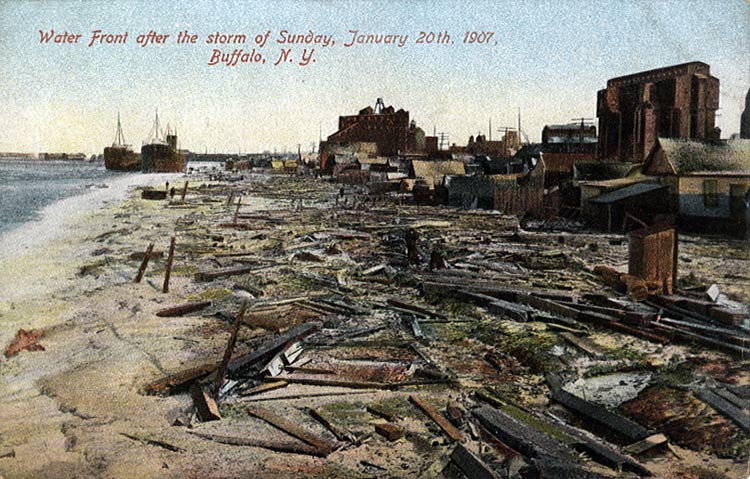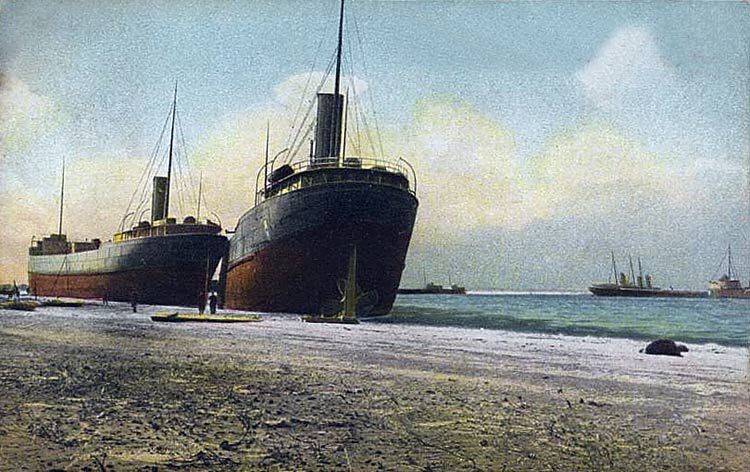When Storms Strike Times Beach
Buffalo's Outer Harbor has been the scene of tremendous damage by weather events over the last century. In 1900, a storm on September 12 caused damage across Buffalo and destroyed much of the breakwater under construction. The Gale in January, 1907, detailed below, was legendary thorughout the country. The breakwall was finished at that time and did its job, but the storm was too great.

Times Beach after the storm of January 1907. The wreckage in the foreground is of cottages and fishing shacks. The grain elevator at top right is the Dakota Elevator, only 3 years old at the time of the storm. Image source: private collection.
Buffalo Express, January 21,1907
BUFFALY BADLY DAMAGED BY GALE
WHICH BLOWS 84 MILES AN HOUR
Boats Beached, Docks Carried Away, Gaps in Breakwater
Shipping along Entire Waterfront Suffers Thousands of Dollars Damage --
Buildings and Signs About the City Wrecked
Street Cars and Electric Lights Temporarily Paralyzed
A Gale of cyclonic force fell upon Buffalo and vicinity yesterday. The waterfront from the Steel Plant to the lower end of Tonawanda is strewn with wreckage. Ships are beached, breakwaters rent and crumbled, houses demolished, docks submerged, and big buildings damaged. The minor damage is widespread.
Estimates to the financial loss vary between $2,000,000 and $3,000,000. It may be greater.
Shipping interests suffered the most. Five big vessels that broke loose from their moorings inside the outer breakwater are aground on the strip of beach near the foot of Michigan Street. Two are loaded with grain. The unusual mildness of the winter previous to the storm helped swell the damage bill. Usually at this time of the year the lake is frozen solid and a storm is not likely to be serious. But yesterday, the heaviest gale in 17 years followed much mild weather. The lake was practicaly free from ice and the strong winds lashed it to mountainous waves.
All of 23 vessels were tied up inside the outer breakwater were made snug for the winter. Their boiler fires were out and hatches down. Most of them had only one or two watchmen aboard. An ordinary summer or fall storm would have found the vessels with full crew, steam up and ready to fight for their lives. The gale yesterday found them nearly helpless.
It was early in the morning when the wind rose and before daybreak great waves were bursting over the breakwater, sending frozen foam high in the air and covering the vessels tied under the lee of the wall.
The wearing weight of one mighty wave after another pounding incessantly taxed the breakwater to its utmost. The newer sections of concrete wall withstood the the onslaught, but about 1,000 feet of timber cribworks on the old wall opposite Michigan street was torn away in sections.
It was while the storm was eating away this cribwork that the vessels were beached. The 23 vessels were protected as long as the crib held, but when it failed, the brunt of the storm reached them. They all tugged fiercely at their anchors. The light vessels dragged theirs first.
About 11 o'clock in the forenoon the Hurlburt W. Smith seemed to free herself of anchored restraint and she came swiftly ashore. She struck on a sand bow about 50 feet from the row of cottages at Michigan Street and the beach. The gale turned her broadside on and she was high and dry this morning.
The William Nottingham, light, followed the Smith ashore, banging the latter's stern as she struck and settled broadside to the lake near the Smith. The J. Q. Riddley came ashore next. She also was light. The unloaded vessels were so buoyant their anchors could not hold them. Later on the Monroe C. Smith and the A.G. Brower, both loaded with grain, took to the beach.
The Hurlburt W. Smith and Nottingham are both high and dry. About the only way they can be got back into the water is by relaunching.
The Monroe C. Smith and the Brower are on sandy bottom about five feet out. They may be lightered and then dredges might get them out. The Ridley is aground, stern on, just south of Michigan Street.
These vessels are all big steel freighters of an average value of $300,000. This is exclusive of cargoes on the M.C. Smith and Brower. It will take days to ascertain just how much the vessels and their cargoes are damaged.
Water Rose 6 to 8 Feet in the River
In the Buffalo River and the Blackwell Canal the water rose six to eight feet and boats, big and little, broke away from their moorings, sustaining more or less damage. The W. Castle Rhodes and the Huron broke loose in the Ohio Basin and rammed the Nellis Redington, damaging themselves and others.
At the Minnesota ore docks, the Frank M. Peavey broke her hawsers and ran into the Erie elevator dock... The Sonora was sunk in drydock. The water came over the gates and flooded out the vessel. Three plates were off her bottom and she was sunk quickly...
Capt. J.J. H. Brown this forenoon estimated that the damage to shipping in Buffalo amounts to $1,500,000. It might go over $2,000,000.
Big Wall of Mutual Elevator Blown Down
But the boats were not the only sufferers along the harbor. Nearly every big building sustained some punishment, anything from a broken window to collapsed wall or total demolition.
The south wall of the Mutual Elevator, better known as the Great Northern, crashed down into a pile of brick and mortar about 2 o'clock in the afternoon. The section of wall that gave way was about 60 feet high by 40 feet long. A shed that adjoined the wall was crushed to earth like a house of cards. This elevator is at the point that seemed to feel the storm the most.
The water in the Blackwell canal here overflowed its banks and ran across the island to Ganson Street and into the Buffalo River. Ald. John P. Sullivan's ice house near the Buffalo Creek railroad bridge was wiped off the map. The ice house was a frame structure about 200 feet square and probably 50 feet high. About noon one wall gave way and soon the rest of the building wabbled itself into such a rickety state that it will have to be torn down. The ice house was worth $10,000.
The high water flooded the fire hole of the Washburn Crosby Company's mill at Michigan Street and the Blackwell canal and the boiler fires were extinguished. A city fire engine had to pump the water out of the cellar when the flood subsided.
Along the lower harbor, from the Bird Island pier to Black Rock, the same situation existed as in the upper harbor, but there were no big vessels to be blown ashore. However, plenty of damage was done. The Belt Line tracks between Georgia Street and Porter Avenue were under water much of the day and were undermined so the roadbed will have to be reballasted. The harbor rose and with it the canal and 11 o'clock in the morning the water in the canal was level with the towpath. A couple of scows were blown ashore on the towpath near the foot of Jersey Street. Boathouses were blown down all along the lower harbor and Squaw Island. The Fort Erie Ferry had to lay up for a day. A scow butted into the Ferry Street bridge and knocked a big hole in it...
The storm came from somewhere down Texas way in the Southern end of the Rockies. It switched up thorugh Wisconsin and then easterly, taking in Buffalo on its way to Eastern Ontario, from where it went off to the St. Lawrence Valley.

Another postcard view of the 1907 storm. Image source: private collection